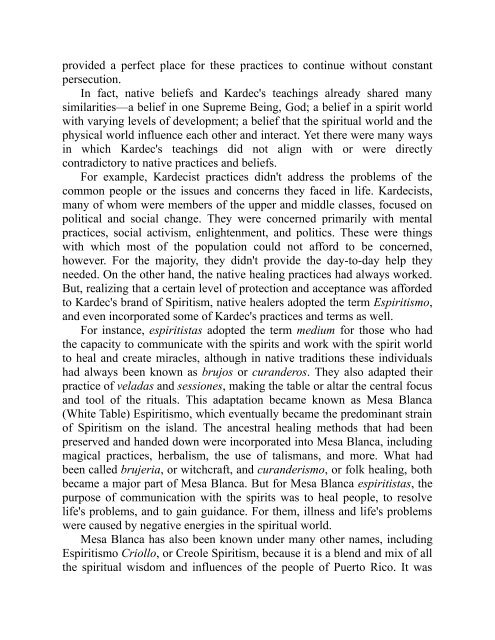You also want an ePaper? Increase the reach of your titles
YUMPU automatically turns print PDFs into web optimized ePapers that Google loves.
provided a perfect place for these practices to continue without constant<br />
persecution.<br />
In fact, native beliefs and Kardec's teachings already shared many<br />
similarities—a belief in one Supreme Being, God; a belief in a spirit world<br />
with varying levels of development; a belief that the spiritual world and the<br />
physical world influence each other and interact. Yet there were many ways<br />
in which Kardec's teachings did not align with or were directly<br />
contradictory to native practices and beliefs.<br />
For example, Kardecist practices didn't address the problems of the<br />
common people or the issues and concerns they faced in life. Kardecists,<br />
many of whom were members of the upper and middle classes, focused on<br />
political and social change. They were concerned primarily with mental<br />
practices, social activism, enlightenment, and politics. These were things<br />
with which most of the population could not afford to be concerned,<br />
however. For the majority, they didn't provide the day-to-day help they<br />
needed. On the other hand, the native healing practices had always worked.<br />
But, realizing that a certain level of protection and acceptance was afforded<br />
to Kardec's brand of Spiritism, native healers adopted the term <strong>Espiritismo</strong>,<br />
and even incorporated some of Kardec's practices and terms as well.<br />
For instance, espiritistas adopted the term medium for those who had<br />
the capacity to communicate with the spirits and work with the spirit world<br />
to heal and create miracles, although in native traditions these individuals<br />
had always been known as brujos or curanderos. They also adapted their<br />
practice of veladas and sessiones, making the table or altar the central focus<br />
and tool of the rituals. This adaptation became known as Mesa Blanca<br />
(White Table) <strong>Espiritismo</strong>, which eventually became the predominant strain<br />
of Spiritism on the island. The ancestral healing methods that had been<br />
preserved and handed down were incorporated into Mesa Blanca, including<br />
magical practices, herbalism, the use of talismans, and more. What had<br />
been called brujeria, or witchcraft, and curanderismo, or folk healing, both<br />
became a major part of Mesa Blanca. But for Mesa Blanca espiritistas, the<br />
purpose of communication with the spirits was to heal people, to resolve<br />
life's problems, and to gain guidance. For them, illness and life's problems<br />
were caused by negative energies in the spiritual world.<br />
Mesa Blanca has also been known under many other names, including<br />
<strong>Espiritismo</strong> Criollo, or Creole Spiritism, because it is a blend and mix of all<br />
the spiritual wisdom and influences of the people of <strong>Puerto</strong> Rico. It was


















